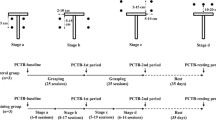Abstract
In order to easily estimate the global cognitive ability of nonhuman primates, we developed a 4-step noncorrection-method-type finger maze (4FM) based on the standard puzzle feeder. We tested 7 experimentally naïve long-tailed macaques (Macaca fascicularis) to assess the validity of the apparatus and the testing procedure. The most notable difference between the 4FM and the standard puzzle feeder is the presence of an error box. There is a hole at both ends of each step. One hole of each step is connected to the lower step or feeding box. The other hole of each step is connected to an error box. The monkey had to move the reward into the feeding box without dropping it into the error box and to retrieve the reward from the feeding box. Task difficulties could be controlled by deciding on which step to place the food reward at the beginning of the trial. All the monkeys could complete the tasks without food/water deprivation and pretraining. The results suggest that the 4FM is a suitable device to assess the cognitive ability of the monkeys simply, easily, and objectively.
Similar content being viewed by others
References
Bachevalier, J., Landis, L. S., Walker, L. C., Brickson, M., Mishkin, M., Price, D. L., and Cork, L. C. (1991). Aged monkeys exhibit behavioral deficits indicative of widespread cerebral dysfunction. Neurobiol. Aging 12: 99-111.
Bloom, K. R., and Cook, M. (1989). Environmental enrichment: Behavioral responses of rhesus to puzzle feeders. Lab. Anim. 18: 25-31
Evans, H. L., Taylor, J. D., Ernst, J., and Graefe, J. F. (1989). Methods to evaluate the wellbeing of laboratory primates: Comparisons of macaques and tamarins. Lab. Anim. Sci. 39: 318-323
French, G. M. (1959). Performance of squirrel monkeys on variants of delayed response. J. Comp. Physiol. Psychol. 52: 741-745
Herndon, J. G., Moss, M. B., Rosene, D. L., and Killiany, R. J. (1997). Patterns of cognitive decline in aged rhesus monkeys. Behav. Brain Res. 87: 25-34
Itoh, K., Izumi, A., and Kojima, S. (2001). Object discrimination learning in aged Japanese monkeys. Behav. Neurosci. 115: 259-270
Katz, J. L., and Mitkin, J. M. (1993). Behavioral effects of dopaminergic agonists and antagonists alone and in combination in the squirrel monkey. Psychopharmacology (Berl.) 113: 19-25.
Kubo, N., Koyama, T., Kawasaki, K., Tsuchida, J., Sankai, T., Terao, K., and Yoshikawa, Y. (2001). Behavioral compensations in a positional learning and memory task by aged monkeys. Behav. Processes 56: 15-22.
Nakamura, K. (2001). Perseverative errors in object discrimination learning by aged Japanese monkeys (Macaca fuscata). J. Exp. Psychol. Anim. Behav. Process 27: 345-353
Novak, M. A., Kinsey, J. H., Jorgensen, M. J., and Hazen, T. J. (1998). Effects of puzzle feeders on pathological behavior in individual housed rhesus monkeys. Am. J. Primatol. 46: 213-227.
Parker, A., and Gaffan, D. (1995). Olfactory–visual associative learning in monkeys depends on intrahemispheric olfactory–visual interaction. Behav. Neurosci. 109: 1045-1051
Ridley, R. M., Pearson, C., Kershaw, T. R., Hodges, H., Maclean, C. J., Hoyle, C., and Baker, H. F. (1997). Learning impairment induced by lesion of the CA1 field of the primate hippocampus: Attempts to ameliorate the impairment by transplantation of fetal CA1 tissue. Exp. Brain Res. 115: 83-94
Sawaguchi, T., and Goleman-Rakic, P. S. (1994). The role of D1-dopamine receptor in working memory: Local injections of dopamine antagonists into the prefrontal cortex of rhesus monkeys confirming an oculomotor delayed-response task. J. Neurophysiol. 71: 515-528
Tomasello, M., and Call, J. (1997). Social Knowledge and Interaction. Primate Cognition, Oxford University Press, New York, pp. 191-230.
Treichler, F. R., and Tilburg, D. V. (1996). Concurrent conditional discrimination tests of transitive inference by macaque monkeys: List linking. J. Exp. Psychol. Anim. Behav. Process 22: 105-117.
Tsuchida, J., Kawasaki, K., Sankai, T., Kubo, N., Terao, K., Koyama, T., Makino, J., and Yoshikawa, Y. (1998, August). Analysis of finger maze learning in cynomolgus monkeys. Poster session presented at the XVIIth Congress of the International Primatological Society, Antananarivo, Madagascar
Tsuchida, J., Kubo, N., and Kojima, S. (2002). Position reversal learning in aged Japanese macaques. Behav. Brain Res. 129: 107-112
Voytko, M. L. (2000). The effects of long-term ovariectomy and estrogen replacement therapy on learning and memory in monkeys (Macaca fascicularis). Behav. Neurosci. 114: 1078-1087
Watson, S. L., Shively, C. A., and Voytko, M. L. (1999). Can puzzle feeders be used as cognitive screening instruments? Differential performance of young and aged female monkeys on a puzzle feeder task. Am. J. Primatol. 49: 195-202.
Whiten, A., Goodall, J., McGrew, W. C., Nishida, T., Reynolds, V., Sugiyama, Y., Tutin, C. E. G., Wrangham, R. W., and Boesch, C. (1999). Cultures in chimpanzees. Nature. 399: 682-685.
Author information
Authors and Affiliations
Rights and permissions
About this article
Cite this article
Tsuchida, J., Kawasaki, K., Sankai, T. et al. New Type of Puzzle-Task Finger Maze Learning in Macaca fascicularis . International Journal of Primatology 24, 261–270 (2003). https://doi.org/10.1023/A:1023040931101
Issue Date:
DOI: https://doi.org/10.1023/A:1023040931101




